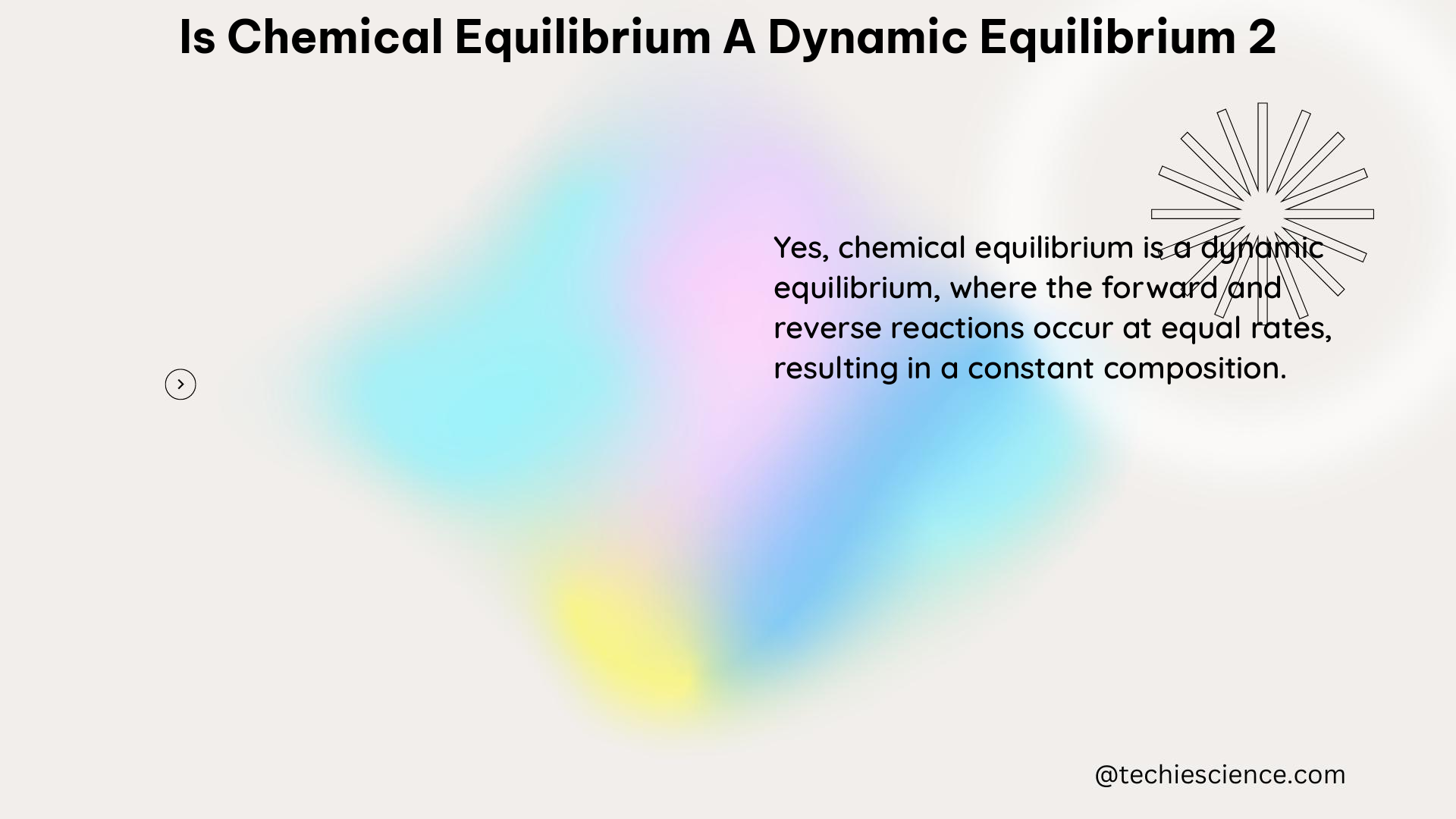Summary
Chemical equilibrium is indeed a dynamic equilibrium, meaning that both the forward and reverse reactions continue to occur even after the equilibrium state has been reached. This is because the rates of the forward and reverse reactions become equal, resulting in no net change in the concentrations of reactants and products over time.
Understanding Dynamic Equilibrium

The Concept of Dynamic Equilibrium
In a chemical reaction, the concept of dynamic equilibrium is crucial to understanding the behavior of the system. Dynamic equilibrium occurs when the rates of the forward and reverse reactions are equal, resulting in no net change in the concentrations of reactants and products over time.
This can be represented by the following general equation:
A + B ⇌ C + D
At equilibrium, the concentrations of A, B, C, and D do not change, but the reactions are still occurring in both directions. This can be visualized as a game of tag, where the “it” person (reactants) and “not it” people (products) are constantly changing, but the total number of “it” and “not it” people remains constant.
The Equilibrium Constant (Keq)
The equilibrium constant (Keq) is a measure of the concentrations of products and reactants at equilibrium and is a constant for a given reaction at a constant temperature. The value of Keq does not depend on the initial concentrations used to reach the point of equilibrium.
The equilibrium constant is defined as:
Keq = [C]^c [D]^d / [A]^a [B]^b
Where:
– [C], [D], [A], and [B] are the equilibrium concentrations of the respective species
– a, b, c, and d are the stoichiometric coefficients of the reaction
Example: Hydrogen and Iodine Reaction
Consider the following reaction:
H2(g) + I2(g) ⇌ 2HI(g)
If we start the reaction with equal initial concentrations of H2 and I2, the reaction will go forward, with the concentrations of hydrogen and iodine decreasing and the concentration of hydrogen iodide increasing until it achieves equilibrium. If we reverse the reaction, the concentration of hydrogen iodide falls while the concentrations of hydrogen and iodine grow until equilibrium is reached.
Properties of an Equilibrium System
The following are the criteria and properties of an equilibrium system:
- Closed System: The system must be closed, which means that no substances may enter or exit it.
- Continuous Reactions: Equilibrium is a living, breathing thing. Even if we cannot see the reactions, both forward and reverse reactions are occurring.
- Equal Reaction Rates: The rates of the forward and backward reactions must be equal.
- Constant Concentrations: The number of reactants and products does not have to be the same. However, once equilibrium is reached, the amounts of reactants and products remain constant.
Factors Affecting Equilibrium
The equilibrium state of a system can be affected by various factors, such as:
- Temperature: Changes in temperature can shift the equilibrium position, as described by the Le Chatelier’s principle.
- Pressure: Changes in pressure can also shift the equilibrium position, particularly for reactions involving gases.
- Concentration: Adding or removing reactants or products can shift the equilibrium position, as described by the Le Chatelier’s principle.
Numerical Examples
- Example 1: Consider the reaction: 2NO(g) + O2(g) ⇌ 2NO2(g)
- At equilibrium, the concentrations are: [NO] = 0.20 M, [O2] = 0.10 M, and [NO2] = 0.40 M.
- Calculate the equilibrium constant (Keq) for this reaction.
Solution:
Keq = [NO2]^2 / ([NO]^2 [O2])
Keq = (0.40)^2 / ((0.20)^2 * 0.10)
Keq = 0.16 / 0.04
Keq = 4.0
- Example 2: Consider the reaction: N2(g) + 3H2(g) ⇌ 2NH3(g)
- At a certain temperature, the equilibrium concentrations are: [N2] = 0.50 M, [H2] = 0.30 M, and [NH3] = 0.70 M.
- Calculate the equilibrium constant (Keq) for this reaction.
Solution:
Keq = [NH3]^2 / ([N2] [H2]^3)
Keq = (0.70)^2 / ((0.50) * (0.30)^3)
Keq = 0.49 / 0.0081
Keq = 60.49
- Example 3: Consider the reaction: 2SO2(g) + O2(g) ⇌ 2SO3(g)
- At a certain temperature, the equilibrium concentrations are: [SO2] = 0.40 M, [O2] = 0.20 M, and [SO3] = 0.60 M.
- Calculate the equilibrium constant (Keq) for this reaction.
Solution:
Keq = [SO3]^2 / ([SO2]^2 [O2])
Keq = (0.60)^2 / ((0.40)^2 * 0.20)
Keq = 0.36 / 0.032
Keq = 11.25
Conclusion
In summary, chemical equilibrium is a dynamic equilibrium in which both the forward and reverse reactions continue to occur, but the rates of the reactions become equal, resulting in no net change in the concentrations of reactants and products over time. The equilibrium constant (Keq) is a measure of the concentrations of products and reactants at equilibrium and is a constant for a given reaction at a constant temperature. Understanding the properties and factors affecting equilibrium is crucial in the study of chemical reactions and their applications.
References
- Chemical equilibrium – Wikipedia: https://en.wikipedia.org/wiki/Chemical_equilibrium
- 15.3: The Idea of Dynamic Chemical Equilibrium – Chemistry LibreTexts: https://chem.libretexts.org/Bookshelves/Introductory_Chemistry/Introductory_Chemistry/15:_Chemical_Equilibrium/15.03:_The_Idea_of_Dynamic_Chemical_Equilibrium
- Equilibrium in Chemical Processes – GeeksforGeeks: https://www.geeksforgeeks.org/equilibrium-in-chemical-processes/
Hi..I am Indrani Banerjee. I completed my bachelor’s degree in mechanical engineering. I am an enthusiastic person and I am a person who is positive about every aspect of life. I like to read Books and listen to music.